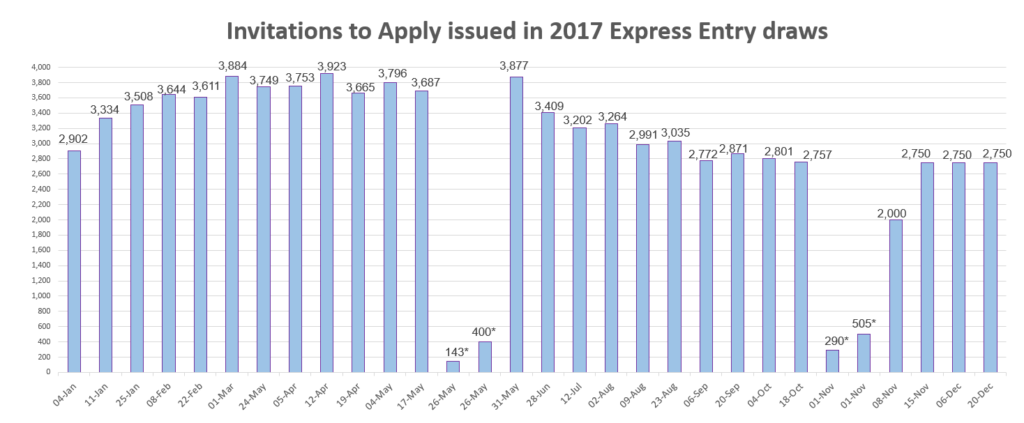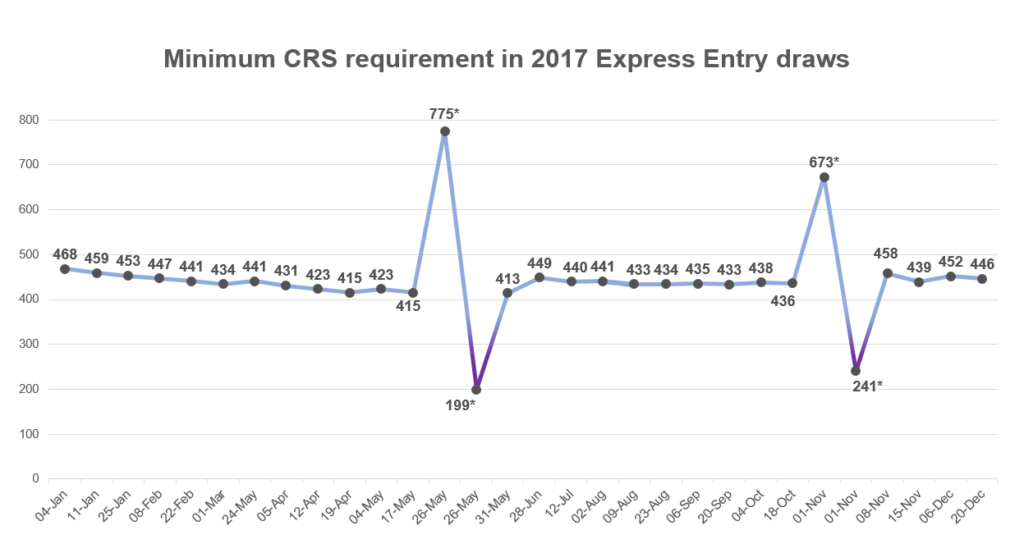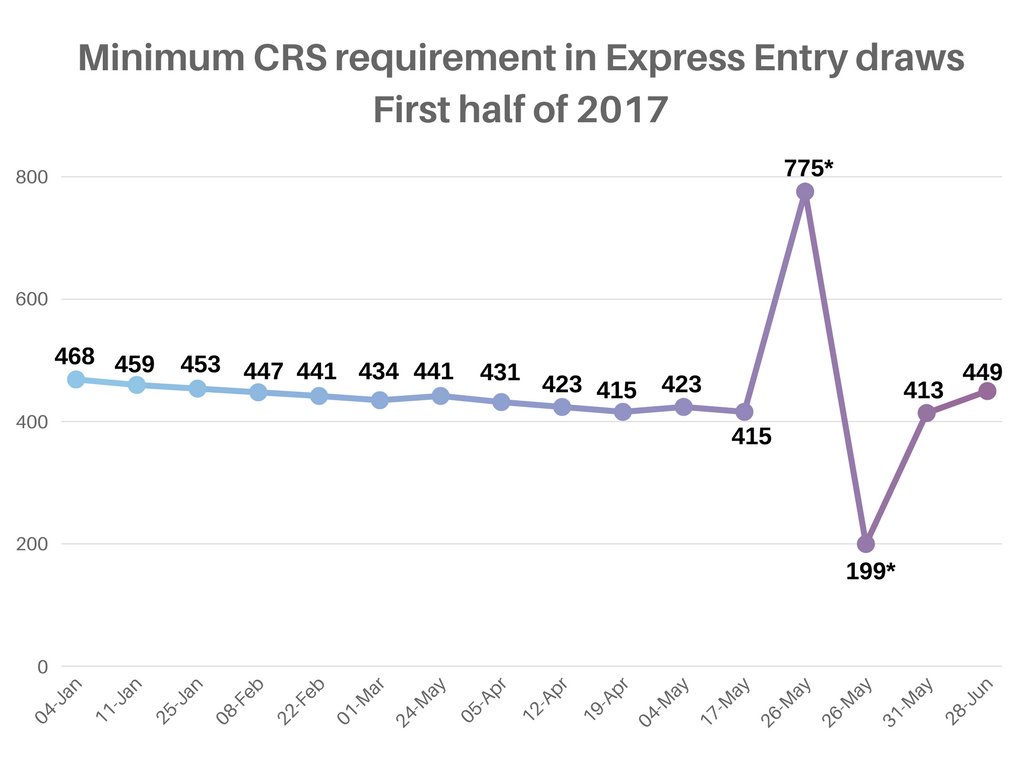2017: A pivotal year in Canadian immigration
To say 2017 was a busy year for Canadian immigration would be a bit like saying Mozart was pretty good at piano.
From the thousands of asylum seekers from Haiti and other countries fleeing uncertainty in the United States to the record numbers posted by Canada's Express Entry selection system, 2017 saw Canada’s immigration system running at full throttle all year long.
In many ways, Canada had a much different year than its continental neighbour, the United States, where President Donald Trump spoke of immigration as a threat to both national security and jobs for American citizens.
From Prime Minister Justin Trudeau on down, Canada promoted a message of inclusivity and opportunity that played out throughout the year at both the federal and provincial levels.
Express Entry
Of all the big immigration stories in 2017, Canada’s Express Entry system led the way.
The year started to see the true potential of the federal government’s two-year-old economic immigration system, which issued 86,023 Invitations to Apply (ITA) to candidates in its three categories — more than twice the 33,782 ITAs issued in 2016.

*Note: These were ITAs issued in program-specific draws.
ITAs are issued in accordance with Express Entry’s Comprehensive Ranking System (CRS), which provides a score to eligible candidates based on criteria ranging from education and proficiency in English to their skilled work experience.
The sharp rise in ITAs issued in 2017 corresponded with significant drops in the cut-off CRS scores over the previous year, whose lowest score was 453. While cut-off scores in the 430s and 440s were most common in 2017, unprecedented lows of 415 and even 413 were seen at various points. Class-specific draws for candidates in the Federal Skilled Trades Class in May and November pushed CRS scores to 199 and 241 respectively.

*Note: Draws of May 26 and November 1 invited provincial nominees and candidates in the Federal Skilled Trades Class only.
Contributing to the drop in the CRS cut-off scores in 2017 was a change introduced by Immigration, Refugees and Citizenship Canada (IRCC) in November 2016 that reduced the number of points awarded for a job offer to between 50 and 200, down from 600. The impact of this change was evident in the cut-off scores for draws in the first half of 2017, which dropped steadily from 468 on January 4 down to 415 in April and finally 413 in May.

IRCC explained that the reduction in points for a job offer was meant to lend more weight to so-called human capital factors like education, language and skilled work experience. This emphasis was enhanced with the introduction of additional CRS points for studies in Canada, a sibling living in Canada, and French language proficiency.
Provincial Nominee Programs
The second big story of 2017 was the growing importance of Canada’s Provincial Nominee Programs, or PNPs. These increasingly popular fast-track programs allow participating provinces and territories to nominate a set number of immigrants each year. In 2017, the federal government had a target of 51,000 nominations under Canada’s various PNPs.
Provincial and territorial governments have been using these programs more effectively and efficiently in recent years to welcome newcomers to their region. Each PNP is tailored to the province or territory’s specific needs and allows it to select nominees who can fill labour shortages and settle quickly.
Many PNPs contain at least one immigration stream aligned with the federal Express Entry system, and they were especially active in 2017.
The Ontario Immigrant Nominee Program’s Human Capital Priorities stream was a case in point. This innovative stream enables Ontario to search the Express Entry pool and select skilled workers with at least 400 CRS points and the required education, work experience, language ability, and other characteristics to successfully establish themselves in the province.
This stream issued Notifications of Interest (NOIs) on a number of occasions in 2017, including a special opening in July that waived the requirement to have at least 400 CRS points for Express Entry candidates with work experience in a number of Information and Communications Technology-related occupations.
Ontario also introduced the new Express Entry Skilled Trades Stream in May to target skilled trades workers who meet labour market needs in the province’s construction and agricultural sectors.
Express Entry-aligned programs in the provinces of Saskatchewan and Nova Scotia were also quite active in 2017. The Express Entry component of Saskatchewan’s International Skilled Worker category opened on five occasions in 2017 to a total of 3,200 applicants wishing to obtain a provincial nomination. On Canada’s East Coast, the Nova Scotia Demand: Express Entry Stream opened on three occasions in 2017. In each of those instances, the intake limit for this first-come, first-served stream was reached quickly and the intake closed later the same day.
With the benefits of Express Entry-aligned PNP streams becoming clearer each year, it comes as no surprise that two of the few provinces without one, Alberta and Manitoba, announced in 2017 that they would be introducing an Express Entry-aligned option in the new year.
Manitoba announced the creation of its Express Entry Pathway as part of a general overhaul of the province’s immigrant nomination program that was unveiled on November 15. A month earlier, Alberta laid out its plans for an Express Entry option alongside a more general streamlining of its PNP that’s due to take effect in 2018.
Atlantic Immigration Pilot Program
The Atlantic provinces of Canada also came together with the federal government to launch a new regionally focused immigration program called the Atlantic Immigration Pilot Program (AIPP).
Whereas PNPs address the labour needs of a single province or territory, the AIPP is an innovative, region-based first that involves the provinces of Nova Scotia, New Brunswick, Prince Edward Island, and Newfoundland and Labrador.
All four provinces face labour and population retention challenges, which the AIPP’s three programs aim to address. Introduced in March 2017, the AIPP was expected to facilitate the entry of a maximum 2,000 principal immigrants into Atlantic Canada by the end of the year.
Family Reunification
Helping families to reunite in Canada is a stated priority for the current federal government and the past year saw a number of important changes that favour this end.
In August, IRCC said it was on track to welcome 84,000 new permanent residents selected on the basis of their family relationship to a Canadian citizen or permanent resident. IRCC said this represents more than 25 per cent of planned immigration to Canada for 2017 and an increase of five per cent over 2016 Family Class immigration levels.
Of that 84,000 new permanent residents, 64,000 were spouses, common-law partners and children and 20,000 were parents and grandparents.
IRCC’s promise to halve processing times for inland sponsorships for spouses and common-law partners from more than 24 to 12 months helped to facilitate the application process. Sponsored spouses and common-law partners also benefited from IRCC’s decision to extend its Open Work Permit Pilot that lets them work in Canada while waiting for their applications to be processed. In April, the federal government also abolished conditional permanent residence status for sponsored spouses and common-law partners.
IRCC also reopened its Parents and Grandparents Program (PGP) in 2017 to accept 10,000 new applications. The government also implemented a new online Interest to Sponsor form to streamline the process along with a random selection process to make it more transparent and fair.
One last but no less significant change to the rules governing family sponsorships was IRCC’s move in October to increase the age of dependents from 19 to under 22.
Citizenship made easier
In October, new rules took effect to help expedite the process of transitioning from Canadian permanent resident status to Canadian citizenship. Among the changes is the new stipulation that permanent residents need to accumulate three years of residency out of five, instead of four years out of six. Also, permanent residents who spent time in Canada as a foreign worker, international student, or protected person before transitioning to permanent residence can now count a portion of this time towards the residency days requirement, where each day spent in Canada on temporary status counts as half a day, up to a maximum of 365 days.
Multi-Year Levels Plan
IRCC capped off 2017 with the Nov. 1 unveiling of its Multi-Year Immigration Plan for the years 2018 through 2020. Heralded by Canada’s Minister of Immigration, Refugees and Citizenship Ahmed Hussen as “the most ambitious immigration levels in recent Canadian history,” the plan would see up to a million new immigrants settle in Canada over its three-year span.
Under the plan, a target of 310,000 new permanent residents will settle in Canada in 2018 across all immigration categories. This target will be increased to 330,000 newcomers in 2019, with a further 340,000 to settle in 2020.

Targets under the new plan would see the number of economic immigrants granted permanent residence through the three Express Entry categories increase by nearly 20 per cent over 2017, from 71,000 to 85,800 in 2020. Provincial Nomination Program allotment targets would also rise by 32 per cent and targets for Family Class immigrants would increase by a little over eight per cent over those of this past year.
Given these numbers, the first six months of 2018 are bound to be big ones for Canadian immigration, and Express Entry in particular. Looking back at 2017, this period saw a big run in ITAs from the Express Entry pool and a sharp drop in CRS scores. With higher targets set for 2018, that could mean more draws and even lower cut-off scores.
If that’s the case, 2018 could be the year many Express Entry candidates have been waiting for.
“The past year was a momentous one for Canadian immigration,” said Attorney David Cohen, senior partner at the immigration law firm Campbell, Cohen. “The many changes we saw in Canadian immigration policy this year reflect a welcome understanding that immigration is not just an opportunity for individual immigrants and their families, but for Canadian society as a whole.”
© 2017 CICNews All Rights Reserved
- Do you need Canadian immigration assistance? Contact the Contact Cohen Immigration Law firm by completing our form
- Send us your feedback or your non-legal assistance questions by emailing us at media@canadavisa.com





